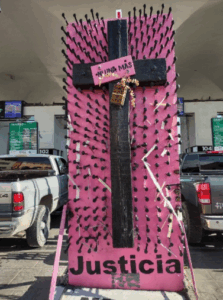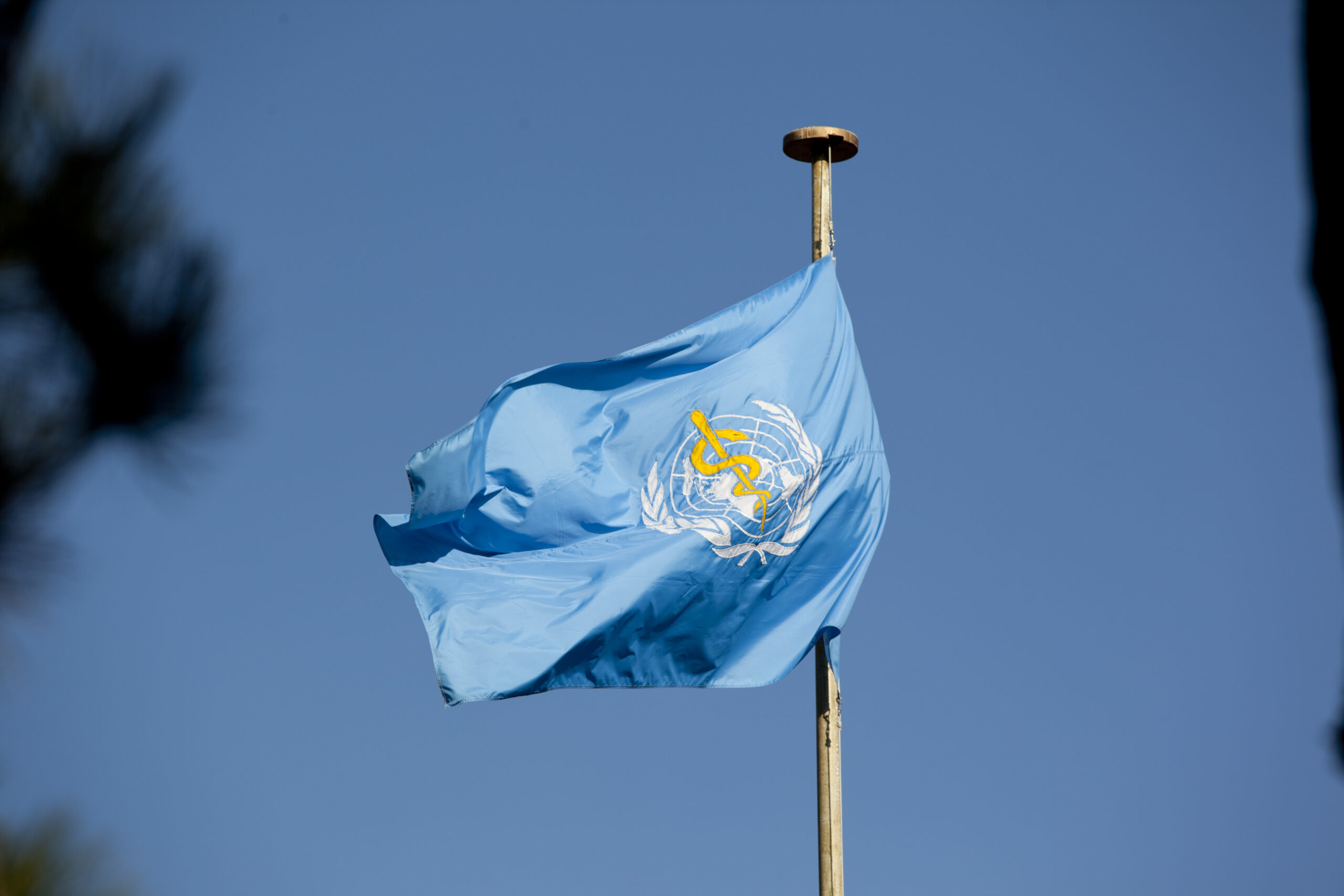Every time I drive my brother to school, a pink cross catches my eye. It’s off by the sidewalk, standing upright, weathered by time and sun. No matter how many times I see it, I never get used to it. I’ll see more of these pink crosses as I keep driving, and sometimes I’ll even see flowers laid below them. They’re a harsh reminder of my town’s injustice against women. Every pink cross is a memorial for the murder of a woman, put up on the site where she was last seen or where her corpse was found. The pink cross is a symbol of the ever-present threat of the most extreme gender-related form of violence: femicide.
Femicide is “a legal and political term to refer to the murder of women killed because they are women.” In contrast to homicide, femicide is gender-based and deeply rooted in misogyny and gender inequality (the way in which the meaning is assigned to sex and gender as social categories creates disparities in resources, such as income, power, and status). The term is meant to raise awareness of this women’s rights issue and the violence many still face today. Femicides occur all over the world, with a report from the United Nations establishing that in 2023, one woman was killed every 10 minutes. Most women were killed by intimate partners, with domestic violence being a significant indicator of danger. Domestic violence can take various shapes, such as psychological, financial, and physical abuse. As domestic violence escalates, the danger for women increases. For example, strangulation or attempted strangulation is the highest predictor of intimate partner violence resulting in femicide.
Although femicides occur worldwide, femicides specific to Central America and Mexico will be our focus throughout this blog. This is due to their extraordinarily high rates and the set of societal circumstances surrounding them. Mass femicides began within these countries a few decades ago, shedding light on the patriarchal culture residing there. Cd. Juarez, Chihuahua Mexico, was the infamous epicenter of these cases. The city gained international attention in the 1990s and early 2000s for the murder and rape of hundreds of women and the government’s failure to protect them. Exact estimates of femicides are hard to establish, due to purposeful misdirection by the legal system and lack of record-keeping. However, some argue that 300–3,000 women have disappeared since the mid-1990s. Young women were taken on their way to work, and their bodies were discovered months or years later, if at all, showing signs of sexual assault, mutilation, and torture. The police rarely ever caught the perpetrators and most of the victims and their families never found justice.
This phenomenon was not an anomaly. It occurred all over Central America and Mexico, with many femicides taking place in Guatemala, Honduras, El Salvador, and Costa Rica. Perpetrators would often target young women from vulnerable conditions, such as those from a low-income background, rural areas, or migrant status. Many of these women were factory workers and worked long hours, which exposed them to lengthy commutes early in the morning or late at night, setting the backdrop for their disappearances.
These acts of violence don’t occur in a vacuum, as they are deeply rooted in the patriarchal structures that dominate society. Patriarchal norms play a significant role in the causes of femicides. In a society where male superiority is established, control over women becomes part of a man’s identity. As heads of households, men exert their authority over their wives and daughters, dictating where they go, what they wear, and who they talk to. Violence becomes a tool to assert their authority and control over them. When women reject patriarchal norms or traditional gender roles, they often face aggression and violence, which can escalate to femicide.
Objectification is another consequence of the patriarchy, where men view women not as individuals but as their property and objects, robbing them of their autonomy. This dehumanization reinforces the idea that men are entitled to women’s bodies, and many men use this entitlement to enact sexual violence. As a result, sexual violence often precedes femicide. These cases demonstrate situations where men prioritize asserting their power and control over women over a woman’s autonomy and life.
 This widespread violence against women was heightened by the failures of government institutions and law enforcement. Across Mexico and Central America, deeply ingrained corruption and systemic patriarchy within the legal system resulted in a lack of justice for these women. Police officers failed to investigate femicide cases, letting suspects go free, and creating a culture of impunity. They often perpetrated violence themselves, ignoring leads and dismissing the voices of victims and their families. When perpetrators escaped punishment, they set an example that women’s lives were negligible. Deeply ingrained patriarchal norms encouraged the police to turn a blind eye. Patriarchies establish male dominance and superiority over women. In a system where women are viewed as lesser-than, their deaths were treated as unimportant and unworthy of pursuing justice. Many femicide victims were blamed for their own murder, minimizing the severity of their deaths or claiming they were isolated events rather than systemic crimes. Due to the lack of effort from law enforcement, many cases of femicide were underreported due to fear of retaliation, social stigma, and distrust of the police officers, especially from families coming from impoverished or marginalized backgrounds that lacked the resources to pursue legal procedures and justice on their own. This complex phenomenon can also be seen through the lens of the General Systems Theory, which establishes that the violence women experience isn’t just about the individual abuser but about the family systems or structure overall, which is made up of multiple people that play varying roles that are changeable over time. The abuse that women have suffered cannot be understood by finding a single perpetrator but by understanding the culture that allowed this violence. The patriarchal narrative and the complicity of law enforcement supported a system where femicides are inconsequential.
This widespread violence against women was heightened by the failures of government institutions and law enforcement. Across Mexico and Central America, deeply ingrained corruption and systemic patriarchy within the legal system resulted in a lack of justice for these women. Police officers failed to investigate femicide cases, letting suspects go free, and creating a culture of impunity. They often perpetrated violence themselves, ignoring leads and dismissing the voices of victims and their families. When perpetrators escaped punishment, they set an example that women’s lives were negligible. Deeply ingrained patriarchal norms encouraged the police to turn a blind eye. Patriarchies establish male dominance and superiority over women. In a system where women are viewed as lesser-than, their deaths were treated as unimportant and unworthy of pursuing justice. Many femicide victims were blamed for their own murder, minimizing the severity of their deaths or claiming they were isolated events rather than systemic crimes. Due to the lack of effort from law enforcement, many cases of femicide were underreported due to fear of retaliation, social stigma, and distrust of the police officers, especially from families coming from impoverished or marginalized backgrounds that lacked the resources to pursue legal procedures and justice on their own. This complex phenomenon can also be seen through the lens of the General Systems Theory, which establishes that the violence women experience isn’t just about the individual abuser but about the family systems or structure overall, which is made up of multiple people that play varying roles that are changeable over time. The abuse that women have suffered cannot be understood by finding a single perpetrator but by understanding the culture that allowed this violence. The patriarchal narrative and the complicity of law enforcement supported a system where femicides are inconsequential.
Despite these barriers, many women and their families have organized to demand justice for the victims of femicide all over Mexico and Central America. Grassroots organizations have formed to demand that law enforcement find missing women and persecute the perpetrators of the femicides. Women have also turned to social media to speak frankly about the patriarchal attitude that permeates their cultures, sharing anecdotes about misogyny and sexual violence. They have protested the legal system that dismisses their plight and have advocated for legal reform. Their work has obtained international attention, and many human rights organizations have grown involved in this process. Feminist activists have succeeded in enacting stricter laws and punishments for aggressors within some countries. They’ve also worked to set up counseling for families and victims of gender-based violence.
 Pink crosses have become a symbol to forever remember this injustice. Sometimes, the crosses come with names or pictures attached. Feminist organizers in Cd. Juarez, my hometown and place of hundreds of missing women, set up a demonstration about these femicides at the border crossing between Mexico and the United States. The “Ni Una Mas” (Not One More) slogan was displayed prominently, demonstrating how they refuse to accept one more murdered woman. Although femicides have decreased greatly in recent years, the misogynistic culture that allowed them to go unpunished still has roots entangled within these countries and feminist efforts to challenge them are still necessary.
Pink crosses have become a symbol to forever remember this injustice. Sometimes, the crosses come with names or pictures attached. Feminist organizers in Cd. Juarez, my hometown and place of hundreds of missing women, set up a demonstration about these femicides at the border crossing between Mexico and the United States. The “Ni Una Mas” (Not One More) slogan was displayed prominently, demonstrating how they refuse to accept one more murdered woman. Although femicides have decreased greatly in recent years, the misogynistic culture that allowed them to go unpunished still has roots entangled within these countries and feminist efforts to challenge them are still necessary.
Ramos is a guest blogger at UITAC Publishing. UITAC’s mission is to provide high-quality, affordable, and socially responsible online course materials.
Images used in this blog:
- Cruces Lomas del Poleo by iose is in the public domain. This image has not been altered.
-
8M en Paraná – Entre Ríos – Paula Kindsvater 8.jpg by Paula Kindsvater is licensed under CC BY-SA 4.0. This image has not been altered.
- (Bianca Ramos. June 29, 2022, Cd. Juarez, Chihuahua, Mexico, Mexico-US Border Crossing)




